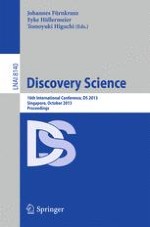This book constitutes the proceedings of the 16th International Conference on Discovery Science, DS 2013, held in Singapore in October 2013, and co-located with the International Conference on Algorithmic Learning Theory, ALT 2013. The 23 papers presented in this volume were carefully reviewed and selected from 52 submissions. They cover recent advances in the development and analysis of methods of automatic scientific knowledge discovery, machine learning, intelligent data analysis, and their application to knowledge discovery.
